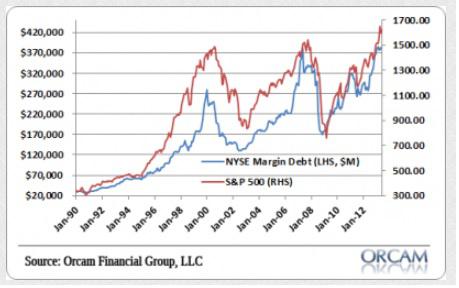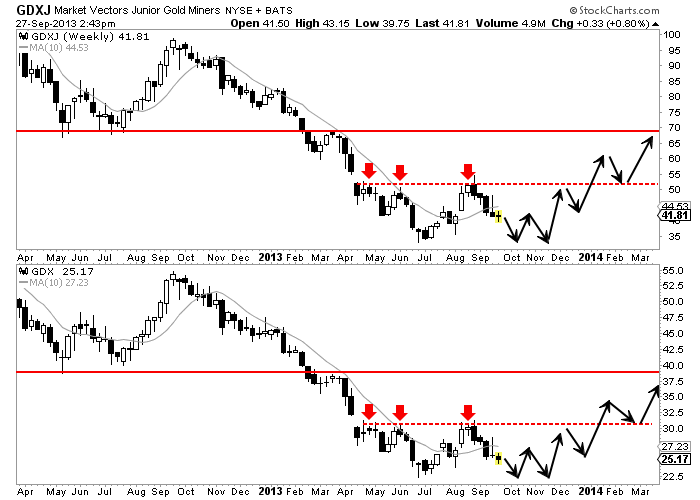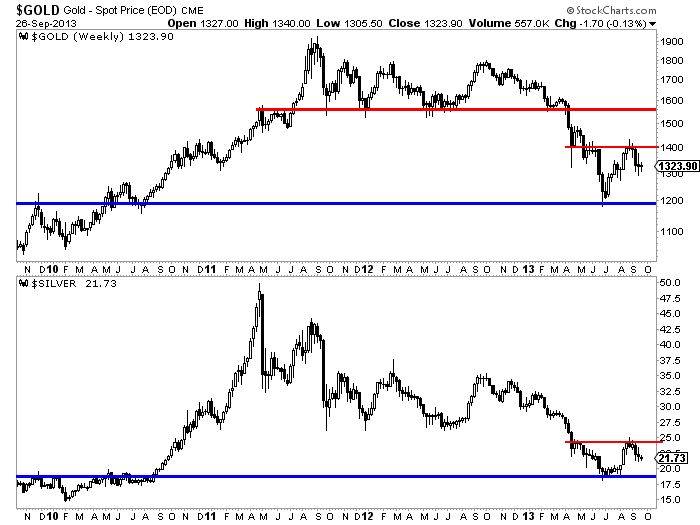Timing & trends
“Basically, price fluctuations have only one significant meaning for the true investor. They provide him with an opportunity to buy wisely when prices fall sharply and to sell wisely when they advance a great deal. At other times he will do better if he forgets about the stock market and pays attention to his dividend returns and to the operating results of his companies.” -Benjamin Graham
Let us just preface this article by stating it is typically very difficult, if not impossible, to properly time the market. We do think, however, that it is possible to lower risks (raising cash) at times when earnings multiples seem elevated to historical averages. We are currently seeing multiple indicators giving warning signs to the astute investor. Since late 2008, we have been fully invested and have ridden up with most of the bull market with very few errors of commission (except Knight Capital), but mainly errors of omission. We think at this point in the market cycle it is time to become more defensive and raise cash levels and/or rotate into lower duration fixed income investments.
Margin debt at all time high.


Though the NYSE has not yet published the August margin data, we can surmise that August will inevitably be higher than July, due to the pattern of markets continuing to find new highs at the beginning of the month. At current levels, we are in new territory with respect to leverage; in our opinion, most of this excess leverage is due to the easy money policies from the fed. It will be quite interesting to see how the markets react when rates get into the 3.0%+ range; we think there is a higher likelihood now for a substantial correction in equity prices of 15-20%. While there is definitely money on the sidelines, we think investors are still justifiably skeptical as a result of the financial crisis of 08′ and 09′. Given the metrics above we feel the next selloff is likely to trigger forced margin selling which could propel stocks sharply lower.

The McClellan oscillator is a market breadth indicator used to evaluate the rate of money entering or leaving the market, and is indicative of overbought and oversold conditions of the market. A recent six month high on the NYSE McClellan Oscillator also may confirm our suspicion that markets have come a little too far, too fast.

The cyclically adjusted P/E ratio is based on the average inflation-adjusted earnings from the prior 10 years. The Shiller cyclically adjusted P/E ratio shows an alarmingly high multiple of 24.27, which is at the high end of the 130 year plus timeframe.
Upward sloping yield curve
While we think the markets are overbought at these levels, the Treasury yield curve is still sharply positive. Therefore, we find it very difficult to be constructively negative long-term with a steep upward sloping yield curve. An inverted yield curve is usually an excellent leading indicator that stocks will enter a bear market within 6-12 months. Yield curve inversions have preceded each of the last seven recessions in the U.S., and we believe that yield curves inversions continue to be one of the most important recessionary indicators.

Though Warren Buffet has put away his elephant gun, we think it is notable that the size of his cash hoard is almost $50 billion. If Buffet is not buying anything in this market, that to us is the equivalent of a sell recommendation. Mr. Buffet hardly ever gives market timing advice, but he has, on numerous occasions, been very close to selling at market tops and buying close to market bottoms. Another notable investor, Seth Klarman, has also been giving investors cash back. Klarman says it is, “to better match our assets under management with the opportunity set we see for new investments”. We think this is yet another sign that Klarman is having a hard time putting his money to work. While these indicators may just be clues, we feel investors at the very least should avoid putting new money to work at today’s market prices.
Our current strategy has been trimming some of our longs like Exco Resources Inc. (XCO) and adding to shorts on large up days like Sandstorm Gold (SAND) and SPDR Gold Trust (GLD). Finally, we also suggest selling short-term out of the money calls on the SPDR S&P 500 (SPY).
Disclaimer: This report is intended for informational purposes only and you, the reader, should not make any financial, investment, or trading decisions based upon the author’s commentary. Although the information set forth above has been obtained or derived from sources believed to be reliable, the author does not make any representation or warranty, express or implied, as to the information’s accuracy or completeness, nor does the author recommend that the above information serve as the basis of any investment decision. Before investing in a security, readers should carefully consider their financial positions and risk tolerances to determine if such a stock selection is appropriate.
At any time, the author of this report may trade in or out of any securities that are mentioned in the report as long or short positions in his own personal portfolio or in client portfolios that he manages without disclosing this information. At the time this report was published, the author had a long position in XCO, and a short position in SAND and GLD; either in his personal account or in accounts that he managed for others.
THIS REPORT IS NOT A RECOMMENDATION TO BUY OR SELL ANY SECURITIES MENTIONED. THE AUTHOR ACCEPTS NO LIABILITY FOR HOW READERS MAY CHOOSE TO UTILIZE THE INFORMATION PRESENTED ABOVE.
Additional disclosure: We are short SAND and GLD, and will potentially enter into a transaction in the SPY within the next 72 hours.

One final comment on TAPER-gate.
A number of strategists and analysts were surprised by Ben Bernanke and the Fed’s decision not to “Taper” the rate of QE money-printing at their September meeting.
However, this behavior from the Fed is not without precedent.
Back in the autumn of 2008 when the Fed first implemented the policy of Quantitative Easing, Ben Bernanke was very quick to assure markets that the Fed would begin to “Exit” from this policy in April of 2009. That helped to make this very experimental policy more palatable.
To “Taper” merely means to slow the rate. But “Exit” refers to a complete reversal of the policy; actually removing the printed money.
Well, April 2009 came and went despite Bernanke’s promise of an “Exit.” Now, here were are five years later, and we have yet to see a single dollar from QE1, QE2, or QE3 removed from the money supply.
This might provide some insight into the Fed’s actual intention to “Taper.” For years they have found reason after reason not to “Exit.” Expect the same with respect to “Tapering.” Over the last three months, Bernanke has become more vocal that “Tapering” is data dependent. Somehow, I sense that the data will tend to be interpreted to support the notion of continued Quantitative Easing. It is unlikely that the policy of QE will never really end until investors say that it has to by pushing market-determined interest rates significantly higher at some point in the future.
Continued Quantitative Easing is not necessarily always the recipe for sizable stock market gains, but it will have the effect of placing a floor under the market and limiting the amount of actual and implied future volatility. This should help to provide a comfortable environment for stock market investors, at least over the near- to mid-term.
The opinions expressed in this report are the opinions of the author and readers should not assume they reflect the opinions or recommendations of Richardson GMP Limited or its affiliates. Assumptions, opinions and estimates constitute the author’s judgment as of the date of this material and are subject to change without notice. We do not warrant the completeness or accuracy of this material, and it should not be relied upon as such. Before acting on any recommendation, you should consider whether it is suitable for your particular circumstances and, if necessary, seek professional advice. Past performance is not indicative of future results.
Richardson GMP Limited, Member Canadian Investor Protection Fund.
Richardson is a trade-mark of James Richardson & Sons, Limited. GMP is a registered trade-mark of GMP Securities L.P. Both used under license by Richardson GMP Limited.

 On Sept 18 markets had to rapidly “re-price” their anticipation of Fed policy when the Fed decided to NOT taper…stocks, bonds and commodities all jumped higher while the US Dollar tumbled. In last week’s blog I wondered if the “re-pricing” would be sustained…or if it would create a “blow-off” top…perhaps even producing a Key Turn Date…when a number of markets reverse direction at the same time signaling an important change in Market Psychology. As we go into October its beginning to look like we had a Key Turn Date on Sept 18/19…setting the stage for big moves ahead.
On Sept 18 markets had to rapidly “re-price” their anticipation of Fed policy when the Fed decided to NOT taper…stocks, bonds and commodities all jumped higher while the US Dollar tumbled. In last week’s blog I wondered if the “re-pricing” would be sustained…or if it would create a “blow-off” top…perhaps even producing a Key Turn Date…when a number of markets reverse direction at the same time signaling an important change in Market Psychology. As we go into October its beginning to look like we had a Key Turn Date on Sept 18/19…setting the stage for big moves ahead.
Here’s what happened since the “re-pricing” of Sept 18 and 19:
Gold: dropped as much as $70 over the next 3 days…rallied back some…closed last week $40 below the “re-pricing” highs.
DJIA: dropped as much as 500 points from the All Time Highs made following the Fed surprise…closed lower in 6 of the last 7 sessions…down 2.7%.
Euro and the Yen: surged higher on the Fed surprise…and pretty much sustained those gains at last week’s close.
CAD: traded to 3 month highs (98 cents) on the Fed surprise but closed last week below 97 cents.
WTI crude: Hit $108 on the Fed surprise…but closed at $103 last week, down $5.
Bonds: The US long bond had a huge 3 point range Sept 18…closing near its highs. Bonds gained another 1½ points last week to reach 2 months highs…with support from several sources… the Fed said the economy was too weak (bond bullish) for them to cut back on their stimulation (more bond buying)…they caught a “safe haven” bid as stocks were sold…and shorts were scrambling to cover after the big sell-off since May.
Potential market turmoil ahead:
Fed: Will or won’t they taper at the Oct 29/30 meeting…a strong employment report this coming Friday (Oct 4) could renew “taper talk.”
Fed: Who will replace Bernanke?
Gov’t: Facing a shutdown on Oct 1…acrimonious political theater…debt ceiling could be reached by mid-October…more acrimonious political theater.
Europe: Now that Merkel is re-elected what changes in Europe?
My short term trading:
In last week’s blog I wrote that stocks and/or gold could be sold short following their quick “Fed surprise” rallies…and that selling pressure in both markets could intensify if they broke below their pre Fed surprise levels. I didn’t want to buy the break in the US Dollar (I’m pre-disposed to be US$ bullish, but the chart pattern looked bearish) and I was neutral on bonds (I felt that a short covering rally was over-due but I could see much higher interest rates ahead.) I chose to short gold because it was already in a downtrend (for the previous 2 weeks, for the last year, for the last 2 years) rather than short stocks which were in an uptrend (for the previous 3 weeks, for the last year, for the last 4 years.)
This past Tuesday (Sept 24) gold traded as much as $70 below its Sept 19 highs…but quickly bounced back. I was thinking that gold might keep dropping…might take out the pre Fed surprise lows at $1291…but it didn’t…so I covered my short term trade with a $38 profit and went to cash…sitting on the sidelines waiting for the market to set up another short term trading opportunity.
I didn’t short the US stock market because it was in an uptrend and picking a top to a bull market that is making All Time Highs is clearly a case of trading what I think the market should be doing rather than what it is doing. I also didn’t short the US stock market because I felt that would be “doubling up” my short on gold…that they were essentially the same trade…that they were both reversing on the same change in Market Psychology. In previous blogs I’ve written that since May I’ve only traded the US stock market from the short side…with plenty of time spent sitting on the sidelines! I’m still pre-disposed to look for an opportunity to get short stocks…but at the moment I’m sitting in cash without a position.
My trading motivation and methodology are intertwined. I don’t like losing money but I’m willing to take risks…I just want to avoid taking stupid risks. So I develop an opinion about Market Psychology to help me gauge where a market is in terms of a bullish or bearish phase…within my selected time frame…and then I wait for a low risk opportunity to establish a position. If the market goes against me I get out with a small loss…if it goes my way I try to add to the trade. If it goes somewhat in my favor, like the gold trade above, but then stops I don’t mind closing the position and going to cash.
Futures and futures options are the best way to trade currencies, metals, stock indices and many other financial and commodity markets. Call 604 664 2842 to talk with Drew Zimmerman

Most of the focus during the week was on the debate in Washington over the budget and debt ceiling with both political parties sniping at each other saying that it will be the other’s fault if the government has to shut down with no budget in place. Obviously, stock markets don’t like these comical displays when they relate to a serious fiscal issue.
There is not a whole lot of leadership in Congress with respect to getting to a resolution ahead of time. However, even more notable, there is no leadership from the president on this issue. Stating that he is not willing to negotiate with respect to the federal budget and the debt ceiling is an extreme position. In the past there has always been give-and-take on these issues. The Acts that that pertain to the debt ceiling and federal budget make it clear that that they are legislative issues to be debated. Declaring that they will not be debated is a sure way to hamper resolution.
One reason for this may be the president’s low standing in opinion polls. A crisis would be a welcome diversion from his performance in other areas. Also, it is usually difficult for the general voting public to grasp the nuances and details of budget debates. As a result, there may be a chance to win in the eye of the public by using rhetoric instead of cooperating.
Despite all the U.S. political shenanigans, history tells us that deals are eventually made at the 11th hour. Also, once that occurs, stocks normally make up more than they lost in the weeks leading up to the deadline. As a result, even though the news sounds bad, it may not be a bad time for the markets (assuming some other event doesn’t come out of left field, like weak corporate earnings for example).
Next Friday October 4th, the U.S. Bureau of Labor Statistics employment report comes out. The Fed is likely going to keep policy unchanged until at least December regardless. As a result, if the employment report is well outside of the consensus either way, the market response might be muted.
October, sometimes a stormy month for markets, looks like it might be a relatively benign stretch despite the storminess of the politics.
Mark Jasayko

In our last editorial we pointed out how the gold stocks had veered off the recovery course. They fell well below the recovery template and fell below their 50-day moving averages. Furthermore, the positive “non-taper” news turned out to be the mother of all bull traps for traders. The market soared on presumably an epic amount of short covering. Yet that only served to be a selling opportunity for traders. That sequence of events only strengthened our view that the sector continues to be headed for a retest which could serve as the mother of all buying opportunities.
The weekly chart of GDXJ and GDX shows these markets sitting between strong support and strong resistance. At current prices, GDX has 12% downside to its daily closing low while GDXJ has 21% downside to its daily closing low. The silver stocks (SIL is not shown) also have 21% downside to their daily closing low. That is probably too much downside for a new low but it doesn’t rule out a retest.

The weekly charts for Gold and Silver show a similar picture. Gold rallied nearly $220 on a daily closing basis. However, it failed at $1400 which is now clear resistance. Similarly, Silver rallied from $18 to nearly $25. There is quite a bit of resistance at $24. We think its unlikely Gold and Silver break past $1400 and $25 anytime soon. We’d first anticipate a retest of the summer lows or at best weeks and weeks of back and forth of action.

The good news for precious metals bulls is this market remains in a bottoming process which should produce a turning point that is on par with those seen in 2000 and 2008. The bad news is we are already five months into this bottoming process and it can continue for several more months. We don’t see widespread news in the sector but it is possible that GDX makes a new low but not GDXJ. It’s possible Gold makes a new low but not Silver. Major divergences are common at major bottoms.
The gold and silver stocks have been in a two and a half year bear market and have shed anywhere from 65% to 78%. Silver has been in a two and a half year bear market and at one point shed nearly 65%. Gold has been in a two-year bear market and has shed 36%. Huge cyclical rebounds aren’t an immediate reaction to the scope of these types of declines. These markets are telling us that the worst is just about over with yet more time is needed for a base that will launch the next phase of this secular bull market. If you don’t believe the next phase is worth waiting for then consider the following. Following these major bottoms the mining stocks have rallied on average 60%-70% within five months. In the two-month rally this summer, SIL rebounded 55% while GDXJ rebounded 63% (both on a daily closing basis). Once this bottoming process moves to its final stages, many stocks will be primed for spectacular rebounds that could occur in weeks and months. Readers are advised to watch closely and spot the companies which show the most strength during this retest. If you’d be interested in our analysis on the companies poised to lead this new bull market, we invite you to learn more about our service.
Jordan Roy-Byrne, CMT
About The Daily Gold
Jordan Roy-Byrne, CMT (Trendsman) is a Chartered Market Technician and member of the Market Technicians Association.. He is the publisher and editor of TheDailyGold Premium, a publication which emphasizes market timing and stock selection for the sophisticated investor.
From 2010-2012 The Daily Gold Premium Model Portfolio was up 131% compared to GDX (+5%) and GDXJ (-11%). In 2012, the Model Portfolio was up 32%, making it arguably one of the top-performing gold/silver stock newsletters. Jordan’s work has been featured in CNBC, Barrons, Financial Times Alphaville, Kitco and Yahoo Finance. He is quoted regularly in Barrons. Jordan has been a speaker at PDAC, Cambridge House and Hard Assets conferences. Jordan earned a degree in General Studies from the University of Washington with a concentration in International Economic Development. He also lived and worked in Southeast Asia for 3 years in order to study economic development from an emerging market perspective. In his spare time he enjoys spending time with Mrs. Trendsman.
Contact: Jordan @ TheDailyGold.com












